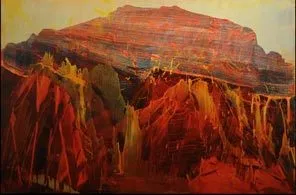
The desert blooms with color, feeling in James Lavadour's work
Oregon artist James Lavadour spins visionary sagebrush-desert themes and variations in an exhibition at Grover/Thurston in Seattle.
By Michael Upchurch
Seattle Times arts writer
No artist has made the sagebrush-desert landscape of eastern Oregon and Washington as much his own as James Lavadour. He is to craggy basalt buttes and blazing brush fires what Monet was to water lilies, haystacks and the chalk cliffs at Étretat.
There's something of J.M.W. Turner's late work ("Rain, Steam and Speed," "Sunrise with Sea Monsters") in his paintings, too: a diffusion of light that both highlights and veils the rugged geological features anchoring almost every Lavadour painting.
Born in 1951 to a family descended from French fur trappers and their Native American wives, Lavadour grew up on the Umatilla Indian Reservation in northeastern Oregon and now lives in Pendleton, Ore. He has lived and breathed the semiarid landscape of the interior Northwest all his life. You might say his work incarnates the surroundings that so deeply and thoroughly shaped him.
A new Lavadour show at Grover/Thurston Gallery includes one oil-on-panel masterpiece in his classic vein, "Red Core," and two sets of oil-on-paper variations in which he invites unlikely shades of a lemon-yellow, turquoise and forest-green into his usual ocher, russet and smoke-gray color scheme.
"Red Core" is a marvel of complexity. You can read it equally as a landscape (a massive butte with rock strata at a shallow tilt, balanced on upthrusts of cliff and canyon) or as pure abstraction (a tumult of shapes and streaks almost jazzlike in their freedom and intricacy). Focus your eyes in a certain way and you'll see rock outcrops, a waterfall, a lone evergreen or two. But what matters is the vitality: drips, seams and flings of color that suggest action painting as much as meticulous natural observation.
Lavadour is eloquent on his own work, and it's worth quoting him: "I began this whole process of extracting a certain kind of knowledge from nature just by engaging with nature. I tried to tell myself not to think — just walk, just see, just feel, just hear. ... I was looking for something that has as much life as the nature that I was experiencing. I did not want a representation, or a depiction, or a portrayal. I wanted something that was an actual event, that was as lifelike as the land that I was walking on."
The titles of the two oil-on-paper series — "1997-2010" and "2001-2010" — allude to Lavadour's years-long compositional process.
"Sometimes I might work on 16 to 20 paintings in a day," he writes, "but only with one color. I might send them back to the closet for six months or a whole year before I begin to figure out how to go beyond where I was."
There are nine paintings in each series, and they offer both striking contrasts and a powerful through-narrative. Where earlier Lavadours depicted curtains and caldrons of flame searing mountain ridges and ravines, some of the new images see fire underpinning the landscape itself.
"1997-2010 #8" works almost like a time-lapse X-ray, revealing the seams of lava that formed the mesas and cliffs of the Columbia Plateau. At the same time, a veiling smoke or mist plays across these turbulent geological formations.
An entirely different effect is achieved in "2001-2010 #9," where bright yellows, suggestive of lava fountains, erupt from a misshapen cone of red. The brush strokes are unusually loose and smeary for Lavadour.
A few other paintings have a more sylvan feel to them. "2001-2010 #3" suggests early-morning sunlight on the eastern Cascade foothills, with sentinellike trees on the ridgeline letting you know: "The rain stops here."
Elsewhere, overt landscape has transcended into abstraction, as though Lavadour has cut loose from his terrestrial springboard and is treading pure atmosphere. Here's a show that hints at an artist pushing toward airier realms of possibility.
http://seattletimes.nwsource.com/html/thearts/2015339133_ar17lavadour.h…